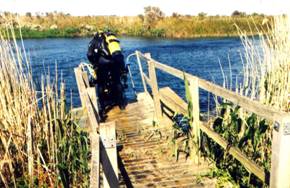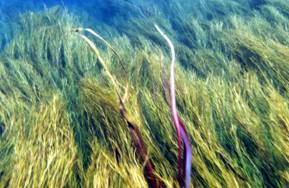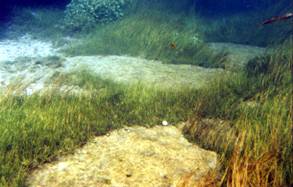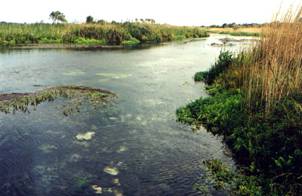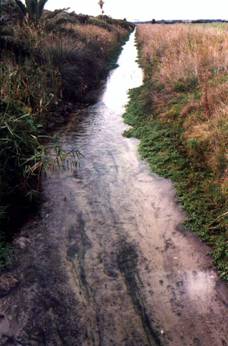Marine Life Society of
South Australia Inc.
Newsletter
January 2006 No. 328
“understanding,
enjoying & caring for our oceans”
Next Meeting
There will be no General Meeting this January.
CONTENTS
Greg Rouse’s
Marine Worm (& Feather Star) Research
Eight Mile Creek Report
The MLSSA Newsletter
The
MLSSA Newsletter is your newsletter and it only exists because of
contributions from MLSSA members.
My
main contributor is Steve Reynolds and he is to be thanked for his diligence in
providing so many articles.
However,
it is important to have a variety of contributors in order to give balance and
range in the topics.
So
can I ask all members and friends of MLSSA to put pen to paper, finger to
keyboard and supply me with some material for the 2006 year. Illustrated
articles are preferred but I can usually source suitable pictures if necessary.
Greg Rouse’s Marine Worm (& Feather Star)
Research
by Steve Reynolds
(Part 2)
Greg wrote that the discovery of Myzostoma australe
“represents the first description of a myzostome from
southern Australian waters” and that it is “distinct from that noted by Grygier (1990) in South Australia, (his species No.37)”.
Now it seems to me that Grygier’s species No.37 is the same one reported in our
February 2004 Newsletter (No.307). The article “New Bluff Resident Discovered”
in that newsletter explained that Myzostoma
seymourcollegiorum “grows to 1cm in diameter and
is symbiotic*, living only on a featherstar (crinoid).
Myzostoma live as free roaming symbionts* on their host featherstars
and are often strikingly camouflaged”.
(* Greg later told me that he considered
that “symbiosis is a very broad term that means ‘living together’. Commensalism is where one species benefits and the other is unaffected; Mutualism is where they both benefit.
Parasitism is where the host is damaged by the other. With Myzostoma
we are often not sure if is commensalism or
parasitism so I used the general term symbiotic.”)
The article explained that “The featherstars are filter feeders that catch plankton from
the water. The worms use their sucking mouths to dip into the food grooves
(like troughs) of the crinoid and take some of the
food before it gets to the crinoid’s mouth”.
It went on to explain that “The host crinoid, Cenolia trichoptera, reaching up to 30cm in diameter, is found
around the southern coast of Australia. It is common in only 2m of water along
the rocky area leading out to the Bluff. This will be the type locality of the
new species of Myzostoma. Cenolia
trichoptera, and hence its fellow-travelling
little worm, can easily be found . .”. More about Cenolia trichoptera later.
A paper, written by Greg Rouse and Mark Grygier, describing Myzostoma
seymourcollegiorum was published mid-2005. It is
titled “Myzostoma seymourcollegiorum
n.sp. (Myzostomida)
from southern Australia, with a description of its larval development”.
A copy of this paper has now been put into our library.
The naming rights for the species went to Mrs Bardie Simpson who wanted to name the worm after her old
school, Seymour College at Glen Osmond, after becoming the successful bidder of an auction held for the rights. Mrs Simpson addressed a school assembly on 22nd
March 2004 to tell the students about naming the worm after their college. The
next day’s Advertiser reported the adoption of the name.
I asked Greg for the full classification
details for Myzostoma. He told me that “Myzostoma is inside Myzostomatidae,
Myzostomida. Where the group goes after that is still
the subject of research. I think they belong inside Phyllodocida,
Annelida but others suggest that they may be closer
to Platyhelminthes. The jury is still out”.
The species of feather stars that Lauren
Johnston was studying for her honours degree in science in 2002 were Aporometra.
These are a variety only found in southern Australia. A
colony of them were found on a reef at Witton
Bluff, near Port Noarlunga. Lauren said that they are very hard to see and
well-camouflaged amongst the seaweed.
The Advertiser of 22nd March
2002 said that “Aporometra is the smallest known variety of feather
star, easily fitting on a human finger tip. It is also unusual because it gives
birth and cares for its young, unlike other feather stars which reproduce by
spawning their sperm and eggs into the sea.”
The article in the paper, written by
Science Reporter Brad Haran, went on to say that
“About 600 kinds of feather star are found internationally, including 70 on the
Great Barrier Reef, but there are only six species in SA. The unusual Aporometra
was named by one of the world’s leading experts on crinoids, the late Dr Austin
Clark, but he did not describe their behaviour or unusual breeding.
“The breeding is thought to work by males
releasing sperm into the water and females catching it in their spectacular
arms, known as pinnules. Eggs are fertilized and
young creatures develop, then new-borns cling to the
arms of their parents until they are old enough to drift free.
“The only other crinoids known to breed
this way are much larger and found in the waters off Antarctica. Ms. Johnston’s
study . . will involve a
detailed analysis of the creatures’ DNA and anatomy, using various technologies
including an electron microscope.”
Marine Inverts. 1 describes Aporometra species as
“Cirri relatively very large, about as long as the arms and not laterally
compressed; arms up to 25mm long”. Only one species from SA is described. It is
Aporometra wilsoni which is said to be “small . . with arms rarely longer than
25mm and brown, orange or red in colour depending on the colour of the host
alga. They often occur in densities exceeding 100 per individual plant. (They) are . . viviparous i.e. the
fertilized eggs undergo development on the pinnules.
The recorded depth . . is to
30m”. The glossary describes ‘pinnules’ as “slender
jointed appendage on arms of crinoids”.
“Sea Stars of Australasia and their
relatives” by Neville Coleman says that “A number of other sea creatures have
formed close relationships with feather stars (and other echinoderms?),
including cling-fish, gobies, snapping shrimps, pontonine
shrimps, squat lobsters, worms, brittle stars and crabs. Small parasitic
molluscs also live on them”.
Neville Coleman’s
“Underwater” magazine (later “Underwater Geographic”), issues 7 & 8
discussed echinoderms including commensalisms and parasitism. Issue 8 said that ’ectoparasites’
are (mollusc) “parasites which retain their shell and can be
seen on the surface or hidden in living galls”. The article features a photo of
the parasitic univalve Stilifer species
burrowed deep into a sea star’s arm, causing a living gall (blister-like
swelling or outgrowth).
In 1971 Neville Coleman discovered and
photographed an undescribed species of commensal worm on the Rhinoceros (or Horned) sea star Protoreaster nodulosus
(or nodosus) - Family Oreasteridae.
That same year he discovered that the Dancing shrimp, Hymenocera
picta was a voracious predator on small sea
stars. I seem to be, however, getting away from the topics of worms and feather
stars.
On page 279 of “Reader’s Digest Book of
the Great Barrier Reef” there is a photo of a (Precious?) clingfish, Lepadichthys lineatus
(or Lepadichthys caritas), clinging
to the arms of a Comanthus feather star. The
caption for the photo says that this “clingfish uses its sucking disk to cling
to the arms of a Comanthus feather star and is
superbly camouflaged by its longitudinal stripes and background colour patterns
which blend perfectly with that of its host*. These fish are predators on other
feather star symbionts – they eat worms and shrimps
and occasionally some of the host’s tissues”.
(* Sounds like a case of
‘allosematic’ colouring –
the use of the colours of another animal by hiding in it or blending with it.)
A (Precious?) clingfish, Lepadichthys caritas can be seen on a feather
star on page 55 of the book “Australian Fish behaviour” by Neville Coleman. The
caption for the photo (a) says that the clingfish is “Only found on and around
feather stars . . (and it) is not as rare as once
thought and occurs over a wide area where its crinoid
hosts are abundant”.
Another little clingfish that may be found
on other echinoderms (& more) can be seen on page 54 of Neville’s book. The
caption for the photo of the Long-nosed clingfish, Diademichthys
lineatus (c) says that it “inhabits sea urchins,
Crown of Thorns sea stars (and) staghorn corals”.
Now for some more details about Cenolia trichoptera.
Greg tells me that the description of Cenolia
trichoptera in Marine Inverts. 1 is actually
another species, Cenolia tasmaniae. A
photo of Cenolia trichoptera
can be seen on page 358 of “Australian Seashores” by Isobel Bennett. Comanthus species such as Comanthus
bennetti, C. japonicus
and Comanthina nobilis
occur on the Great Barrier Reef and photos of these species can be seen in
“Reader’s Digest Book of the Great Barrier Reef”, Reader’s Digest Services P/L,
Sydney, 1984.
Now for more details
about Ptilometra macronema. “Sea Stars of Australasia and their
relatives” by Neville Coleman describes Ptilometra
macronema as follows: - “Family: Ptilometridae, Common Name: Long-cirried
feather star, Distribution: Temperate seas, Depth: 25 – 120m, Habitat: Rocky
reefs, Food: Plankton, Size: 150mm and Notes: The long-cirried
feather star is found attached to algae, rocky reefs, bryozoans and gorgonians.
The species is extremely prevalent in the deeper waters throughout its
distribution, and its colour pattern seems to be constant. The animal is firm
to the touch with spiny arms and extremely long cirri which it uses to cling to
objects on the bottom. The first specimen of this species was studied in Europe
over 130 years ago, the type locality being given as King George Sound,
south-western Australia. It can be distinguished from its eastern counterpart,
the southern feather star (Ptilometra
australis), by the number of arms on adult specimens (25 to 31), and in
most cases P. australis is dark purple. Both species are generally fully
expanded night and day.” Marine Inverts. 1 describes Ptilometra macronema
as having “Pinnules spike-like, stiff, upstanding and triangular in
cross-section; arms to 70-80mm long” and “An attractive species with brittle
arms delicately coloured orange, red or purple, common in deeper water (20-50m)
attached to sponges, bryozoa or rock. The species
ranges from Shark Bay, WA to Port Phillip Bay, Vic.”.
There is a photo of Ptilometra macronema
by the late Kevin Branden in the book (Plate 29.1).
Another photo can be found in Neville Coleman’s book (on page12).
As discussed earlier, polychaetes
used to be divided into the two Orders Errantia and Sedentaria according to whether they are ‘free-wandering’ (Errantia) or they are modified for a permanent life in
tubes or sand-burrows (Sedentaria). When I asked Greg
about this later, he directed me to :-
http://tolweb.org/tree?group=Annelida&contgroup=Bilateria
. I have kept a file copy of the web page which included the following comments
about ‘Errantia’ and ‘Sedentaria’'.
“Until relatively recently the most
commonly used system to divide polychaetes was as ‘Errantia’ and ‘Sedentaria’. This
was essentially a system of convenience with no real intention of depicting
evolutionary relationships. This classification was supplanted in the 1960s and
1970s by ones which split polychaetes into as many as
22 orders with no explicit linkage between them (Fauchald
and Rouse, 1997). A recent cladistic analysis of Annelida and other groups has resulted in a new
classification of polychaetes (Rouse and Fauchald, 1997). This used an evolutionary tree of worms as
the basis for the naming of groups. There are two major branches containing all
polychaetes- Scolecida and Palpata. Scolecida is a small
group of less than 1000 named species, and these worms are all burrowers of one
form or another, with bodies reminiscent of earthworms. Palpata
comprises the vast majority of polychaetes and is
divided into two branches; Aciculata and Canalipalpata. Aciculata contains
about half of the polychaete species and largely
encompasses the old taxonomic group Errantia.
Representatives of this lineage are characterized by having internal supporting
chaetae, or aciculae, in the parapodia.
It includes major groups such as Phyllodocida and Eunicida, which tend to be mobile forms with well-developed
eyes and parapodia for rapid locomotion. Canalipalpata, a group with more than 5000 named species,
is distinguished by having long grooved palp
structures that are used for feeding. Canalipalpata
is then subdivided into Sabellida, Spionida and Terebellida. Most of
these groups’ members live in tubes and use their palps*
to feed in various ways.”
(*A glossary in Marine Inverts. 1
describes ‘palps’
as being “paired projections arising from the sides of the head” and these are
illustrated in Fig.6.6B (bp) on page 244 of that
book.)
I asked Greg to explain the many names
used on the web page. I asked him “Which names are Class, Order, Family, etc.. - Scolecida and Palpata, Aciculata and Canalipalpata, Phyllodocida and Eunicida, Sabellida, Spionida and Terebellida?” and
“Are all those that end in ‘ida’ Orders, those that
end in ‘ata’ Classes and those that end in ‘idea’
Families?” He told me “For a variety of reasons I tend not to use taxonomic
ranks such as Class, Order or Family. The ending ‘idae’
is only used for family but the other names were developed as a rankless classification. People have applied them with
ranks in various ways and I’ve done this for you on your Excel spreadsheet.
FYI, I’ve attached a very technical article on why I am for a new system”.
The attachment was a paper titled (in
French) “Ceci n’est pas une pipe:names,
clades and phylogenetic
nomenclature” which had been written by Fredrik Pleijel
and Greg Rouse. It was an introduction to the literature and to issues relating
to phylogentic nomenclature and the PhyloCode, together with a critique of the current Linnaean
system of nomenclature. This paper has been added to our library.
I also asked Greg if he could suggest the
necessary changes to the worm section of our Photo Index Excel spreadsheet
file. He made several changes to the file himself and I was then able to copy
those details straight into our complete spreadsheet file. Work on the
spreadsheet is still continuing with Greg’s assistance.
I see from many of the above mentioned
papers that Greg Rouse has also written many more papers, including “A cladistic analysis of Siboglinidae
Caulerry, 1914 (Polychaeta,
Annelida): formerly the phyla Pogonophora
and Vestimentifera”, Zool.
J. Linn. Soc. 132, 55-80”, 2001. He also
co-wrote (with K Fauchald) “The articulation of
annelids”, Zool. Scr. 24,
269-301, 1995.
Many of Greg’s papers include
photomicrography. “Encounter 2002 Expedition to the Isles of St Francis, South
Australia: Myzostoma australe
(Myzostomida), A new crinoid
associated worm from South Australia” features photos of Myzostoma
australe and “Myzostoma
seymourcollegiorum n.sp.
(Myzostomida) from southern
Australia, with a description of its larval development” features photos of Myzostoma seymourcollegiorum.
The book “Marine Flatworms – The World of Polyclads” by Leslie Newman and Lester Cannon, a recent
acquisition for our library (mlssa No.1055), has a good chapter about worms in
general, including marine worms.
BIBLIOGRAPHY:
“Greg Rouse – worms and featherstars” file including newspaper cuttings – mlssa
2215.
“Encounter 2002
Expedition to the Isles of St Francis, South Australia: Myzostoma
australe (Myzostomida),
A new crinoid associated worm from South Australia”
in the “Transactions of the Royal Society of South Australia (2003), 127(2),
265-268, 28 November, 2003” – mlssa No.2216.
“Myzostoma seymourcollegiorum
n.sp. (Myzostomida)
from southern Australia, with a description of its larval development” by Greg
Rouse and Mark Grygier, Zootaxa
1010:53-64 (2005), ISSN 1175-5326 (print edition) ISSN 1175-5334 (online
edition) – mlssa No.2217.
“Annelida” by Greg Rouse, Fredrik Pleijel and Damhnait McHugh
- mlssa No.2218.“Worms
discovered living on whale bones” (source unknown) – mlssa No.2220.
“Polychaetes” by GW Rouse & F Pleijel, Oxford University Press, London, 2001.
“Australian Seashores” by
Isobel Bennett, Angus & Robertson Publishers, Australia, 1987.
“Reader’s Digest Book of the
Great Barrier Reef”, Reader’s Digest Services P/L, Sydney, 1984.
“Australian
Fish Behaviour” by Neville Coleman’s Underwater Geographic Pty Ltd, Queensland,
1993.
“A Dictionary of Biology” by
Abercrombie, Hickman & Johnson, Penguin Books, England, 1970.
(All pictures
were taken on previous trips.)
Pond #3 Exit - shows previous exit for divers from Ponds.
This has now
been repaired and has a small floating pontoon attached.
I made the
following observations:
Eight Mile
Creek1 - shows Eight Mile Creek swim from the Ponds downstream.
Eight Mile
Creek2 - shows Eight Mile Creek swim from the Ponds downstream,
with some of the bedrock creek bed.
Eight Mile
Creek3 - shows Eight Mile Creek recovering
from having been stripped bare of its aquatic vegetation.
You can be
sure I will report back once more after I have done so, and have some pictures
to share.
Drain #5 -
shows the drain after spraying with herbicide.
Today this
drain is green all over in places.
The far end
is the exit from Spencers Pond
